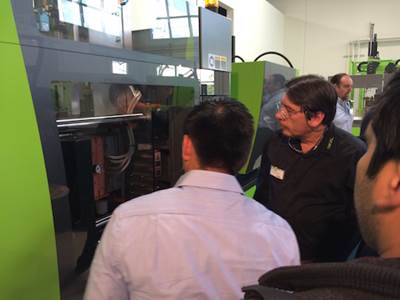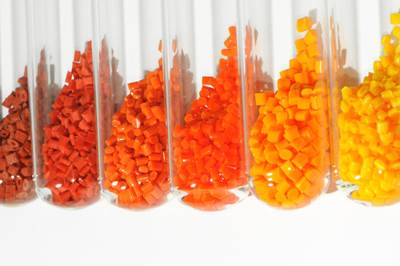Back to the (Re)Grind
Some amount of scrap—generated in startup, shutdown or defective parts—is inevitable. How can you reclaim regrind into new profitable parts?
The first step in regrind processing is understanding the reasons for scrap production. Scrap is a waste of material and machine time. In the world of plastics production, profit margins can be quite thin, and a plant’s success is highly dependent upon production systems execution. There is no question whether the reintroduction of scrap materials into the molding system is necessary. Failure to recapture material lost due to startup, defect production and press shutdown could negatively impact a company’s profit margin.
First, molders must understand that defect scrap is produced primarily by not controlling the overall production process. Scrap does not have to be inevitable. It is the result of poor monitoring and control and a failed processing approach.
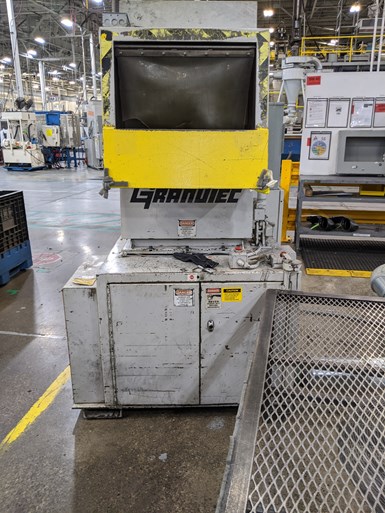
Regrind needs to be uniform to assure that virgin-regrind blends are consistent.
This article will explain the pros, cons and procedures of regrind processing. There will always be a need to reprocess lost materials, but there also needs to be an understanding that scrap prevention is the first and most profitable response. Scrap is lost product, which increases machine time during a production run. A company’s primary goal is to first eliminate scrap, thus increasing productivity and profits.
Scrap Data and Approach
The first steps in scrap reduction revolve around scrap data. What jobs are producing scrap, and why is scrap being produced? Scrap is never an “acceptable” condition! Look to the rules of “5M” for answers. Is the scrap a result of: Man, Mold, Material, Machine or Method (Process)? These simple steps can often reveal what the actual cause of scrap might be, which will help your technical support team develop solutions for eliminating scrap events.
Scrap is the result of poor monitoring and control and a failed processing approach.
It is important to note that eliminating scrap is not easy. Every company has its own set of scrap producers, which will require a fundamental approach to reduce, if not eliminate, scrap events. But in every scrap situation, there must be a clear understanding that accepting scrap as a normal factor of production only tolerates applying “band-aids” as a normal step in production. Make a list of your top five scrap producers, evaluate the reasons for scrap events, and develop a plan to remove scrap from the equation.
Material Candidates for Regrind Usage
One of the most important considerations in developing a regrind approach is material type and visual aesthetics. Class “A” parts can be adversely affected by regrind usage. Lower ratios of regrind may be used successfully, but sampling must take place to determine the best approach.
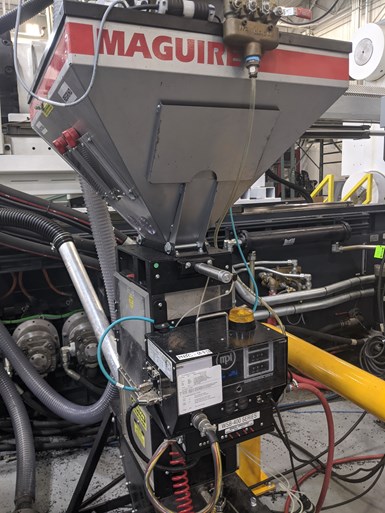
Regrind reintroduced at the press should be processed through a blender to assure a consistent ratio of regrind:virgin.
Material blends are another factor that must be considered. Mineral- and glass-filled materials may require lower regrind ratios. Drying might be required in some cases.
Glass-filled materials may require “generational” monitoring. Each time this material is ground, the length of the glass fiber is shortened. This can affect not only the process but the part’s impact and shrink properties.
The following materials are great candidates for reprocessing:
• Polypropylene;
• Polyethylene;
• Polystyrene;
• ABS;
• PC/ABS;
• Polycarbonate (colored/ non-optical);
• Nylon (glass content must be considered when determining ratio).
Clear polycarbonate regrind can be used, but it is important to note that regrind use can affect part clarity, which in optical applications is a critical component.
Regrind Approaches and Procedures
While working on eliminating scrap from your facility, there is still a need to recoup lost materials. The following points are crucial when reprocessing materials for production.
Grinder selection is key to press-side reprocessing. Regrind granules need to be uniform to assure that virgin-regrind blends are consistent during the reprocessing event.
Use of regrind that has been reprocessed is the most direct path to process consistency. Materials should be re-extruded with virgin base added to improve process consistency. Both the virgin material and reprocessed blends should have separate validated processes to assure process control.
Make a list of your top five scrap producers; evaluate the reasons for scrap events; and develop a plan to remove scrap from the equation.
Regrind reintroduced at the press should be processed through a blender to assure mix-ratio consistency. The virgin/regrind ratio should be based on the ability to maintain upper/lower control limits in the established process window.
It is important to note that press-side regrind usage is prone to housekeeping issues. There is a certain amount of material dusting and upkeep that has a direct relationship to at-the-press regrind use. Processing regrind in an enclosed grinding area helps to eliminate much of the mess from the molding floor.
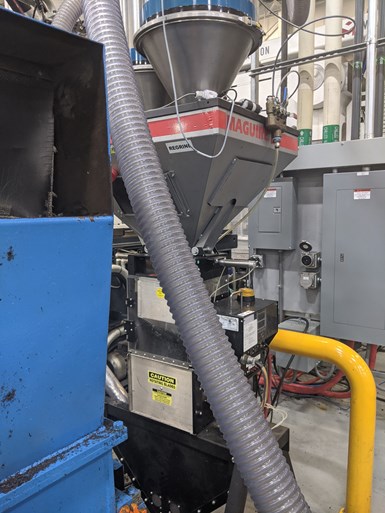
Virgin material and reprocessed blends should have separate validated processes to assure process control.
Keeping reground materials free of contaminants and cross-contamination with other materials is critical to reprocessing. Extensive training of all personnel who will be involved in the reuse process is critical to the success of reprocessing material.
The first step towards regrind processing is the elimination of scrap from the production floor entirely. When regrind use is required, make sure that your facility plans its reprocessing plan carefully to ensure that the end result is full use of materials lost during the production process. Material reuse is not the preferred method of production control, but controlling material losses is key to assuring ROI on resin purchases.
ABOUT THE AUTHOR: Garrett MacKenzie is the owner/editor of plastic411.com, as well as a consultant/trainer in plastic injection molding. He has provided process-engineering expertise to many top companies, including Glock, Honda, Johnson Controls and Rubbermaid, and currently works for a company that provides automotive products to Yenfeng, Faurecia and other top automotive suppliers. Contact: garrett@plastic411.com.
Related Content
Bulk, Solid and Melt Density: How to Calculate These Values and Why They Matter — Part 2 of 2
Understanding and calculating solid density and melt density will help molders with everything from material and machine selection to determining piece part costs.
Read MoreUsing Data to Pinpoint Cosmetic Defect Causes in Injection Molded Parts
Taking a step back and identifying the root cause of a cosmetic flaw can help molders focus on what corrective actions need to be taken.
Read MoreImprove Production Rates Via Screw Design — Barrier vs. General Purpose vs. Melt Uniformity
I’m looking for a few good molders to help trial a new screw design, and share data and results for a future article to prove the benefits of a melt uniformity screw.
Read MoreA Systematic Approach to Process Development
The path to a no-baby-sitting injection molding process is paved with data and can be found by following certain steps.
Read MoreRead Next
The 5 M’s of Molding—Part I: Man (labor)
There are many areas in which personnel affect consistency and repeatability within a plastics operation.
Read MoreQuick Changeover: The 3-to-7-Minute Color Change
Step 1: Assessment—These questions must be asked during the development of fast changeover procedures.
Read More





















